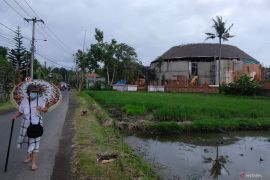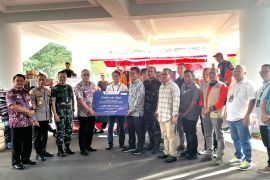the current tsunami early warning system called InaTEWs, which is being developed by Indonesia, is quite good as it can provide potential tsunami information within five minutes.Jakarta (ANTARA News) - For most Indonesians, the memories of the deadly tsunami, which devastated Aceh Darussalam Province and Nias Ditrict (North Sumatra Province) just one day after Christmas about ten years ago, are still fresh in their minds.
The tsunami, which was triggered by a 9.0-magnitude earthquake that rocked Aceh on Dec. 26, 2004, has been the most devastating one in living memory. It affected 18 countries in Southeast Asia and Southern Africa, killed more than 250 thousand people in a single day, and left more than 1.7 million people homeless.
In Aceh and Nias alone, the tsunami caused wide-scale destruction, killed more than 200 thousand people and rendered some one million people homeless.
Malaysia, Thailand, Sri Lanka, India, Maldives, Bangladesh, Somalia, and Tanzania were among the 17 countries affected by the tsunami.
To commemorate the 10th year of the catastrophe, an international conference on tsunami was organized in Jakarta on Nov. 24, 2014. Twenty-four countries located around the Indian Ocean participated in the event.
Twenty-one of the 24 countries receive early warning for tsunami.
Many international organizations such as the UNESCO, WMO, and ASEAN sent their representatives to the conference that was organized by the Indonesian Meteorological, Climatology and Geophysics Agency (BMKG).
BMKG Chairman Andi Eka Sakya said the conferences recommendations will serve as inputs for a UN conference on disaster mitigation to be held in Sendai, Japan, on March 14-18, 2015.
"This conference is also to mark the establishment of the Indian Ocean Tsunami Early Warning and Mitigation System," Skaya noted.
Pushed by the 2004 tsunami, many nations in the Indian Ocean region have put early warning systems in place.
Since 2012, for instance, the Regional Tsunami Service Providers (RTSPs) in India, Indonesia, and Australia have become the primary source of tsunami advisories in the Indian Ocean region.
"Just knowing history is not enough, we should be able to prevent casualties when a tsunami similar to that of 2004 strikes in the future," Indonesias Research, Technology and Higher Education Minister M. Nasir stated in his opening remarks at the one-day conference.
The minister expressed hope that Indonesia would have a better tsunami early warning system similar to the Japanese system that would ensure zero casualty.
He, however, added the current tsunami early warning system called InaTEWs, which is being developed by Indonesia, is quite good as it can provide potential tsunami information within five minutes.
Director of Science from the United Nations Educational, Scientific and Cultural Organization (UNESCO) for Asia Region Hubert J Gijzen praised Indonesia for developing the best anti-tsunami warning system in the world.
"Ever since a tsunami hit Indonesias Aceh province in 2004, the country has been developing a tsunami warning system, and it has turned out to be the best in the world," Hubert stated during the opening ceremony of the conference.
According to Gijzen, an early warning system for tsunami can reduce the number of casualties. Indonesia learned its lesson when the December 2004 tsunami devastated Aceh province, claimed the lives of 230,000 people, and seriously damaged its coastal areas.
"The impact of the 2004 tsunami was huge. What we need to understand here is that although we cannot stop a tsunami from happening, we can warn the people well in advance before a tsunami strikes," noted Gijzen.
The UNESCO Director also called for international collaboration in developing early warning systems for possible tsunamis.
"International collaboration is very crucial because one country cannot single-handedly deal with a large-scale calamity such as tsunami," he remarked.
Sutopo Purwo Nugroho, a spokesman for the Natural Disaster Mitigation Agency (BNPB), recently observed that the government must pay serious attention to early warning system infrastructures because the county was prone to natural disasters such as tsunami and earthquake.
Between 1629 and 2014, 174 major tsunamis have hit the country.
Some five million people in Indonesia live in coastal areas that are susceptible to tsunamis.
He pointed out that Indonesias early warning infrastructure was insufficient considering its vast coastline.
Indonesia has 4,500 kilometers of long coastal lines that are vulnerable to tsunamis, but only 38 sirens are available when, ideally, there should be one thousand sirens.
According to him, of the total 2,500 evacuation shelters needed, the country has only 50 shelters.
Meanwhile, the Aceh provincial government has expressed hope that President Joko "Jokowi" Widodo would attend a commemoration of the 10th year of the 2004 tsunami.
"We hope President Jokowi and a number of ministers attend the function in remembrance of the 10th anniversary of the tsunami in Aceh," the Head of the provincial Culture and Tourism Office, Reza Pahlevi, said in Banda Aceh recently.
Pahlevi pointed out that apart from the remembrance ceremony, a mass prayer will also be held on December 25 at the Baiturrahman Grand Mosque in Banda Aceh.
"The people of Aceh have high hopes to see the President and his ministers at the event. The Presidents presence will boost the development works in Aceh," he added.
The government of Aceh also invited the representatives of the 21 donor countries and 16 agencies, which had helped in rebuilding the province after the tsunami, to attend the event.(*)
Reporter: Fardah
Editor: Heru Purwanto
Copyright © ANTARA 2014











